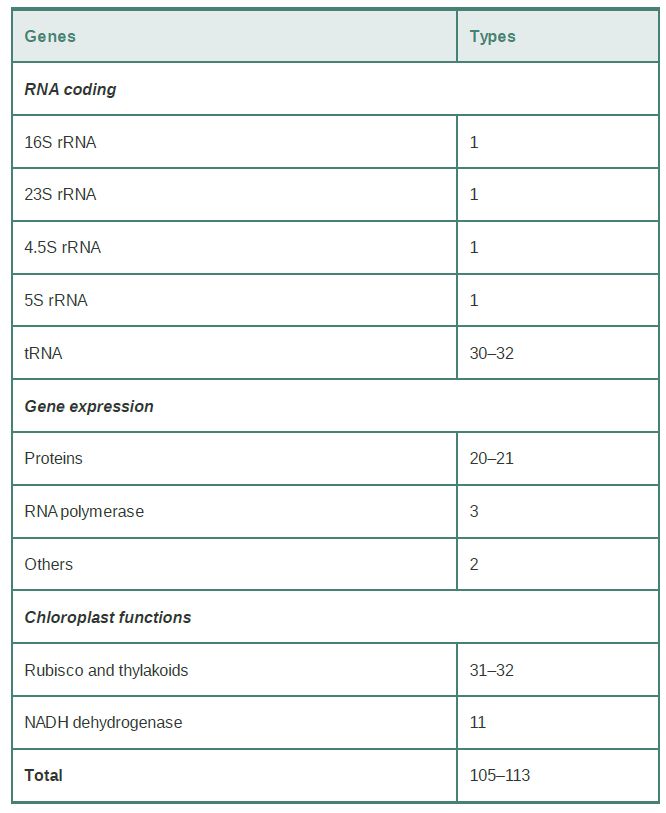


 النبات
النبات
 الحيوان
الحيوان
 الأحياء المجهرية
الأحياء المجهرية
 علم الأمراض
علم الأمراض
 التقانة الإحيائية
التقانة الإحيائية
 التقنية الحيوية المكروبية
التقنية الحيوية المكروبية
 التقنية الحياتية النانوية
التقنية الحياتية النانوية
 علم الأجنة
علم الأجنة
 الأحياء الجزيئي
الأحياء الجزيئي
 علم وظائف الأعضاء
علم وظائف الأعضاء
 الغدد
الغدد
 المضادات الحيوية
المضادات الحيوية|
Read More
Date: 26-4-2016
Date: 27-12-2015
Date: 11-5-2016
|
The Chloroplast Genome Encodes Many Proteins and RNAs
KEY CONCEPT
-Chloroplast genomes vary in size, but are large enough to encode 50 to 100 proteins as well as the rRNAs and tRNAs.
What genes are carried by chloroplasts? Chloroplast DNAs vary in length from about 120 to 217 kb (the largest in geranium). The sequenced chloroplast genomes (more than 200 in total) have 87 to 183 genes. TABLE 1 summarizes the functions encoded by the chloroplast genome in land plants. There is more variation in the chloroplast genomes of algae.
TABLE 1 The chloroplast genome in land plants encodes 4 rRNAs, 30 tRNAs, and about 60 proteins .

The chloroplast genome is generally similar to that of mitochondria, except that there are more genes. The chloroplast genome encodes all the rRNAs and tRNAs needed for protein synthesis in the chloroplast. The ribosome includes two small rRNAs in addition to the major ones. The tRNA set can include all of the necessary genes. The chloroplast genome encodes about 50 proteins, including RNA polymerase and ribosomal proteins. Again, the rule is that organelle genes are transcribed and translated within the organelle. About half of the chloroplast genes encode proteins involved in protein synthesis.
Introns in chloroplasts fall into two general classes. Those in tRNA genes are usually (although not inevitably) located in the anticodon loop, like the introns found in yeast nuclear tRNA genes . Those in protein-coding genes resemble the introns of mitochondrial genes . This places the endosymbiotic event at a time in evolution before the separation of prokaryotes with
uninterrupted genes.
The chloroplast is the site of photosynthesis. Many of its genes encode proteins of photosynthetic complexes located in the thylakoid membranes. The constitution of these complexes shows a different balance from that of mitochondrial complexes. Although some complexes are like mitochondrial complexes in that they have some subunits encoded by the organelle genome and some by the nuclear genome, other chloroplast complexes are encoded entirely by one genome. For example, the gene for the large subunit of ribulose bisphosphate carboxylase (RuBisCO, which catalyzes the carbon fixation reaction of the Calvin cycle), rbcL, is contained in the chloroplast genome; variation in this gene is frequently used as a basis for reconstructing plant phylogenies. However, the gene for the small RuBisCO subunit, rbcS, is usually carried in the nuclear genome. On the other hand, genes for photosystem protein complexes are found on the chloroplast genome, whereas those for the light-harvesting complex (LHC) proteins are nuclear encoded.



|
|
|
|
دراسة يابانية لتقليل مخاطر أمراض المواليد منخفضي الوزن
|
|
|
|
|
|
|
اكتشاف أكبر مرجان في العالم قبالة سواحل جزر سليمان
|
|
|
|
|
|
|
اتحاد كليات الطب الملكية البريطانية يشيد بالمستوى العلمي لطلبة جامعة العميد وبيئتها التعليمية
|
|
|